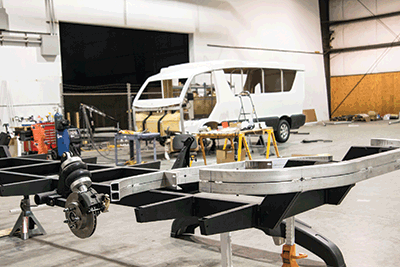A generation ago, electric cars were widely dismissed as a pipe dream. A decade ago, many saw them as underpowered and over-priced. But today, with gas prices hovering near $4 a gallon and battery prices dropping fast, electric vehicle sales are taking off and creating new opportunities for car makers and suppliers to grow – including, sometimes, in Southwest Washington.
Sapa Extrusions, which makes aluminum components in Vancouver, is selling parts to electric car and motorcycle makers. Ryno Motors, which started in Vancouver before moving to Oregon, partnered with Washington State University Vancouver to test its one-wheeled electric vehicle back in 2011. And Vancouver-based Pangea Motors has global ambitions as it ramps up manufacturing of an electric bus in the Philippines.
And the timing of these efforts could not be better, according to industry statistics. According to Green Car Reports, the 96,000 plug-in electric cars that sold in the U.S. last year represent just a tiny fraction of new vehicle sales – about half of a percent, in a market with 16.5 million vehicles. But that’s 25 times more than what sold just three years ago, according to BMW estimates. Beyond U.S. borders, electric is even more popular, with 400,000 vehicles selling last year, and more than a million expected to sell by 2016.
Tesla, the most famous electric car maker in the U.S., is heavily targeting Chinese auto buyers. And some of those overseas drivers may be inadvertently supporting Clark County jobs. That’s because Sapa Extrusions, which employs about 100 people in Vancouver, is making components for Tesla. Sapa officials declined to discuss the details of this arrangement, citing confidentiality agreements with the auto company. But they did confirm the existence of the relationship – and of another electric vehicle relationship as well, making electric motorcycle components for Oregon-based Brammo.
Then there’s Ryno Motors, now based in Beaverton, but with deep roots in Vancouver. The Ryno is a vehicle that’s hard to get your head around even when you’re looking right at it: a seat and handlebars like you’d find on a motorcycle, positioned on top of a single large wheel, the most robust electric unicycle you’re likely to see on the road. Though founder Christopher Hoffman has moved his company out of Clark County, he still used Washington State University Vancouver’s help with endurance testing.
If Ryno and Sapa both tie Southwest Washington to the electronic car industry in small ways, it’s Pangea Motors that has the biggest ambitions within the sector. Yet, ironically, Pangea’s vehicles are also the least likely of the bunch to roll down local streets in the next few years.
That’s because Pangea is targeting the Philippines as it works to fulfill its first 300 sales of electric vehicles, and as it prepares to ultimately manufacture 3,000 vehicles per year. The product: The Comet, a 16-passenger shuttle bus.
David Boyd, electric car designer with Pangea, said there are two reasons that his company is launching the Comet overseas: First, technological advances have finally made electric vehicles affordable for buyers in developing nations. Second, there’s a huge opportunity in the Phillipines’ capital city, Manila, where popular shuttles called “jeepneys” are falling out of favor.
“Jeepneys have become a sort of indigenous form of transportation in the Phillipines,” Boyd said. “The problem is that a lot of them are very old, they are highly polluting, and because of operational costs the drivers don’t make very much money. So we started working on designing a jeepney replacement that was fully electric, using modern technology and looking at better methods to use the vehicle.”
Driving an electric vehicle at high speeds on a U.S. highway will drain its batteries fast, but at the slow speeds Pangea’s Comet would encounter in the heavy traffic of Manila and other big cities, the battery can stay charged for much longer, Boyd said.
Pangea worked to make the Comet affordable, comfortable and inexpensive to operate – a promise that has led to several hundred initial sales. The largest jeepney operator in Manila is discussing a purchase of 10,000 more Comets, as well, Boyd said.
As Pangea pushes sales of the Comet overseas, the company is also working to develop its next electric vehicle, the Resort. The Resort is a four-seat, low-speed electric vehicle. It looks like a high-end golf cart, but is distinct in a number of ways, Boyd said. Golf carts have low maximum speeds, and are not designed to be road worthy, while the Resort will be street-legal.
“It’s not designed for golf courses, but for urban environments and low-speed environments like beach communities,” Boyd said. “You can bomb around town in it. It’s perfect for islands, resort areas, gated communities.”
Both the Comet and the Resort are low-speed vehicles built for niche applications – an area that Pangea sees as ripe with market opportunities – in part because regulations for vehicles that travel on city streets but not freeways are simpler than for all-purpose cars.
What’s behind the opportunities that Pangea Motors, Sapa, Ryno and others are pursuing?
“Power and electronics have been coming down in cost … The cost of lithium batteries has dropped,” Boyd said. But more than that, “Improvements in battery technology over the past five to 10 years are driving the entire electric vehicle industry right now, combined with growing demand.”




